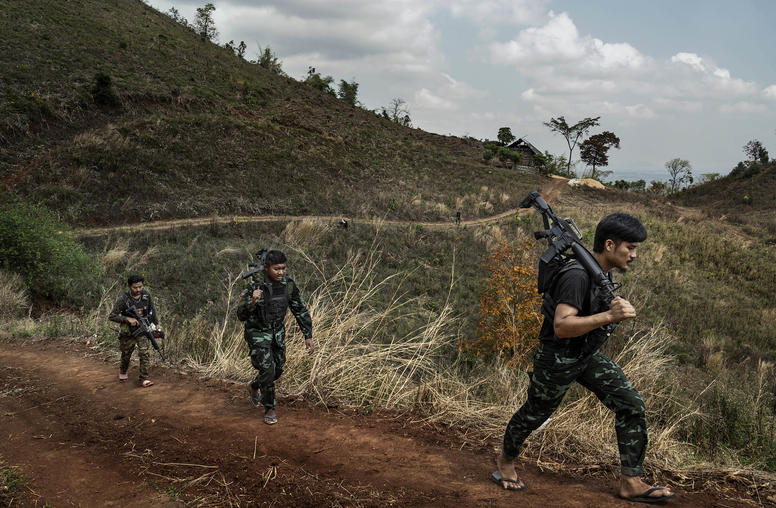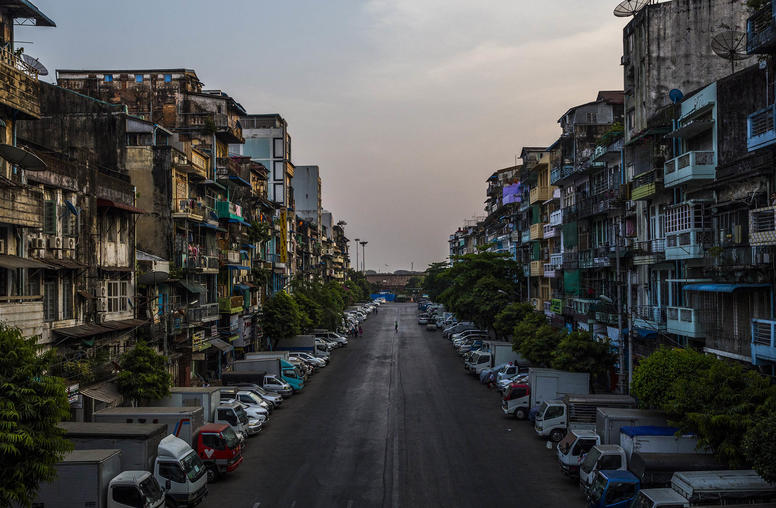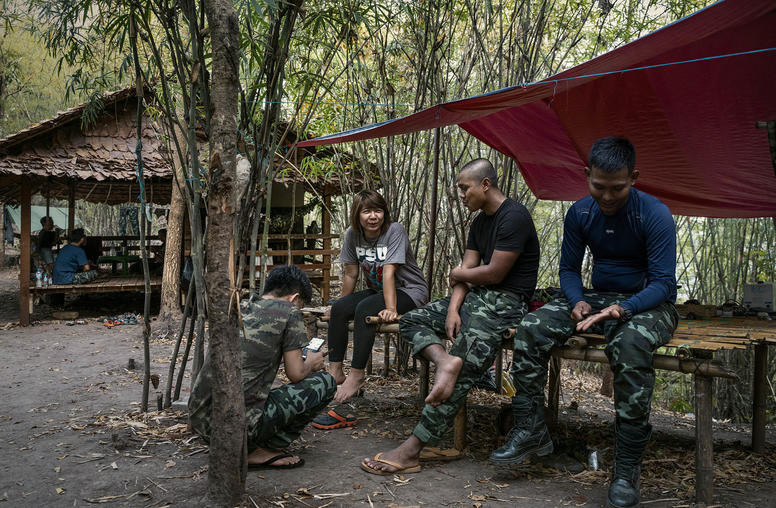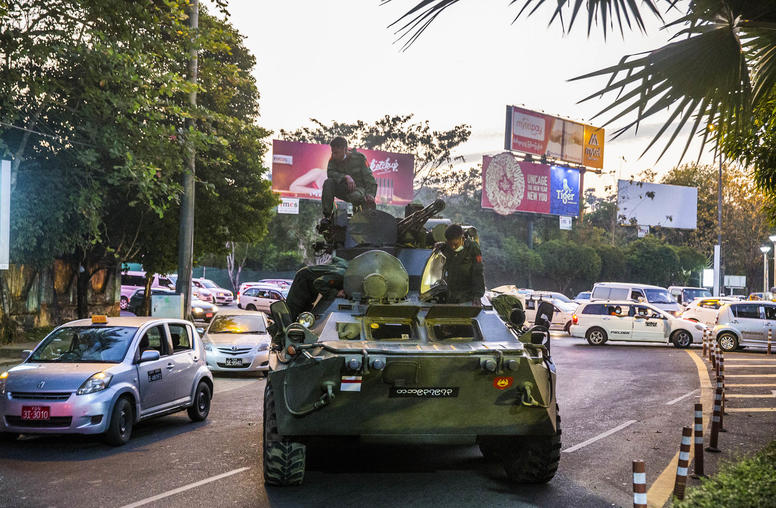On the Issues: Burma
Susan Hayward discusses how Burma's "saffron revolution" demonstrates the powerful capacity of the religious realm to assist in the creation of global peace.
Image on right: Civilians join Buddhist monks during a march in protest against the military government in Burma on Sept. 24, 2007. (Photo: AP)
 The most recent protest in Burma, on October 31, 2007, took place in Pakokku, northwest of Rangoon. Pakokku is a center of Buddhist learning, home to more than 80 monasteries and to the emergence of the country’s largest anti-government protests in nearly two decades.
The most recent protest in Burma, on October 31, 2007, took place in Pakokku, northwest of Rangoon. Pakokku is a center of Buddhist learning, home to more than 80 monasteries and to the emergence of the country’s largest anti-government protests in nearly two decades.
The large protests that occurred in September 2007, in which hundreds of thousands of Buddhist monks and nuns took to the streets of cities throughout the country, captured the world’s attention. These manifestations brought greatly needed attention to bear on the oppressive Burmese regime, leading to follow-up visits by UN envoy Ibrahim Gambari and increased U.S. sanctions against the ruling elite.
These protests were remarkable in part because of the striking centrality of religious figures and symbols to the movement. The monastics stood up to the heavily armed military with nothing more lethal than empty alms bowls, chanted Buddhist prayers, and called for greater compassion for the people of Burma on the part of the ruling military junta and the international community.
 The staff of USIP’s Religion and Peacemaking program analyzes and supports the ability of religious leaders and communities to build peace and reconciliation. In this interview, Program Officer Susan Hayward highlights what these recent protests demonstrate about the powerful capacity of the religious realm to assist in the creation of global peace and justice.
The staff of USIP’s Religion and Peacemaking program analyzes and supports the ability of religious leaders and communities to build peace and reconciliation. In this interview, Program Officer Susan Hayward highlights what these recent protests demonstrate about the powerful capacity of the religious realm to assist in the creation of global peace and justice.
- When some people think of the religious realm’s influence on global conflict, they are quick to point to the potential negative impact of religious leaders and communities from many faiths. How does what is occurring in Burma challenge these assumptions about religion’s influence in politics?
- What do religious monastics such as Buddhist monks and nuns bring to a political protest movement that distinguishes it from protests led by other sectors of civil society?
- The protesters appeared to be remarkably committed to nonviolence in their protest. Is that a reflection of the religious clergy’s involvement in the protest?
- Are there other practical or logistical ways in which the religious realm is well-suited to mobilize social or political movements?
- What is the impact of these protests and concurrent attention on the broader global Buddhist community? Have they galvanized other monks and nuns?
- What do you think the future holds for the monks of Burma?
What the world saw in Burma recently was, among other things, an illustration of the persistent role of religion in the realm of politics across the globe. As increasingly proclaimed by government officials, diplomats, and international organizations, and as undeniably proven by the events of September 11, 2001, the ongoing sectarian violence in Iraq, and outbreaks of violent Hindu nationalism in India, religion continues to influence politics in much of the world.
Many are quick to point to the negative effects of the religious realm in fueling political violence and division. However, the monks and nuns in the streets of Rangoon have demonstrated the positive and powerful influence the religious sector can have in propelling movements of nonviolent protest, human rights, and self-determination worldwide.
Most broadly, religious leaders are able to offer a powerful moral-spiritual indictment. This is particularly the case in strongly religious countries such as Burma where the population reveres its monastics. This cultural respect for monks and nuns subsequently makes it harder for government authorities to convince the public that protesting monks or nuns are subversive, dangerous, or criminal elements who are a threat to the population. The reverence afforded monastics may also make it harder for individual soldiers—often peasant villagers, such as the case with the current military forces in Burma—to violate internalized cultural norms by inflicting violence against them. In contrast, if the protest was comprised of, for example, students, the security forces might be more willing to resort to violence quickly in order to put it down.
The symbolic power religious clergy draw from their tradition to make provocative and resonant statements in the midst of the theater of protest is notable. Take for example the overturned alms bowls monks held up in the face of the junta’s soldiers. In Buddhist tradition, adherents secure spiritual support through providing material support to the Buddhist monastic community. For thousands of years this exchange has been conducted by monks traveling house-to-house with alms bowls for lay adherents to fill with food. In inverting their bowls in the faces of the soldiers, the monks refused to provide their antagonists the ability to fulfill this religious obligation and so gain merit believed to secure prosperity and security in their lives. This is a powerful image of condemnation within a Buddhist society.
In spiritually condemning the junta, the monastics were also able to withhold the legitimizing power of religion from the ruling junta. Many governments worldwide draw support and legitimacy for their rule by eliciting the blessing of religious leaders. The Burmese junta certainly has attempted to enlist the blessing of elements of the Buddhist community and to cloak their rule in Buddhist piety in the past. The monks’ condemnation of the junta in the mass protests, however, will now make it incredibly difficult for the junta to claim to be a blessed and legitimate rulership.
The monks drew on other religious resources as well, chanting memorized sutras advocating Buddhist commitments to loving-kindness as a rallying cry and moral critique, pausing in prayerful meditative silence outside the home of Aung San Suu Kyi, and so forth. Through accessing and enacting religious symbolic resources, the protest message of the monks resonated deeply within the culture, conjuring a persuasiveness that discursive rhetoric or chanted political statements alone simply cannot touch.
It’s undeniable that political action on the part of religious figures and communities is sometimes violent. Religious leaders worldwide, from virtually every tradition, have led violent movements throughout history.
Yet it is also undeniable that many of the major successful non-violent political resistance movements in the past century have been grounded in religious values and led by prominent spiritual figures. Gandhi, Abdul Ghaffer Khan, Martin Luther King, Jr., Desmond Tutu, and others drew from their religious tradition’s ethical basis to argue for a moral commitment to non-violence. They nurtured a spiritual resolve and power to face brutal responses from oppressive political powers. They also encouraged reconciliation and a vision of a shared future with former enemies upon achieving their political goals.
Within religious traditions, in other words, there are many resources to nurture deeply held ethical commitments to non-violent forms of resistance. The Burmese Buddhist monastic community’s adherence to non-violence certainly was influenced by Buddhist ethical commitments to compassion. The nonviolent nature of their protest arguably made it more persuasive to international observers as the brutal nature of the junta was starkly revealed when it responded with violence to unarmed monks and nuns carrying signs advocating love and compassion.
Absolutely. The swift mobilization of monasteries throughout Burma revealed the power of religious institutions to mobilize social movements effectively and efficiently. Throughout the world, religious communities are connected across national populations. This provides the capacity to liaise, send messages, and mobilize mass movements that can effectively challenge abusive governments and respond quickly to particular events. Through this powerful capacity to broadly network and mobilize, the Burmese monastic community was likely able to coordinate more easily its hundreds of thousands of monks and nuns and their local populations to create an impressive show of resistance.
Buddhist monastic communities in other Asian countries took note of the activities of the monks and nuns in Burma and the violence the junta inflicted against them. Several prominent Buddhist leaders, including the Dalai Lama, voiced messages of solidarity. This support from fellow monastics amplifies the message of the Burmese monks and undoubtedly provides them strength to continue their protest.
Image on right: Protestors shout slogans during a rally in Burma, Aug. 26, 2007. (Photo: AP)
 Political mobilization by monks is by no means an uncommon practice in Asian history. For example, in Cambodia and other countries, the Buddhist monastic community mobilized to oppose colonialism in the Twentieth Century. Many may remember images of monks self-immolating in protest to the Vietnam War. Throughout Buddhist history, there have always been some monastics who have forgone reclusive forest-dwelling meditation in order to work actively in society to reduce suffering for others. Social and political involvement by the Buddhist monastic community took even more vigorous forms in the past two centuries. It is important to note that political action by Asian Buddhist monks has not always been for the purpose of peace and justice. In Sri Lanka, Vietnam, and even in Burmese history, groups of monks have mobilized in support of repressive policies or regimes. But the current Burmese monastic movement is waged against political oppression and in support of democracy and justice for the Burmese people. The attention and support it has garnered, which has stirred debate within the wider Buddhist monastic community, encourages conversation around Buddhist teachings on peace and social justice. The debate also pushes monastic communities to take seriously the manner in which they can positively influence social and political situations, the responsibility they have to do so, and the most appropriate form of action this requires. To the extent that it will inspire a new wave of political or social action by monks and nuns in Asia, we will have to wait to see.
Political mobilization by monks is by no means an uncommon practice in Asian history. For example, in Cambodia and other countries, the Buddhist monastic community mobilized to oppose colonialism in the Twentieth Century. Many may remember images of monks self-immolating in protest to the Vietnam War. Throughout Buddhist history, there have always been some monastics who have forgone reclusive forest-dwelling meditation in order to work actively in society to reduce suffering for others. Social and political involvement by the Buddhist monastic community took even more vigorous forms in the past two centuries. It is important to note that political action by Asian Buddhist monks has not always been for the purpose of peace and justice. In Sri Lanka, Vietnam, and even in Burmese history, groups of monks have mobilized in support of repressive policies or regimes. But the current Burmese monastic movement is waged against political oppression and in support of democracy and justice for the Burmese people. The attention and support it has garnered, which has stirred debate within the wider Buddhist monastic community, encourages conversation around Buddhist teachings on peace and social justice. The debate also pushes monastic communities to take seriously the manner in which they can positively influence social and political situations, the responsibility they have to do so, and the most appropriate form of action this requires. To the extent that it will inspire a new wave of political or social action by monks and nuns in Asia, we will have to wait to see.
What do you think the future holds for the monks of Burma?
Following the violent crackdown on last month’s protests, it appeared that the monks had been silenced—either through jailing or intimidation. However, the re-emergence of a smaller protest on October 31 demonstrated that the spirit of resistance remains alive. The monks are drawing from incredible deposits of resolve to continue to mobilize peacefully. It gives me optimism to see their commitment to continue to foment opposition and wage non-violent protest. Hopefully, this message will continue to motivate the international realm to put pressure on the ruling junta to reform. I hope that the monk’s persistence will also continue to inspire hope amongst the oppressed Burmese population and encourage them to persevere in their struggle. The Burmese monks and nuns truly demonstrate the best of the religious realm’s capacity to build global peace and justice.
The views expressed here are not necessarily those of USIP, which does not advocate specific policy positions.



